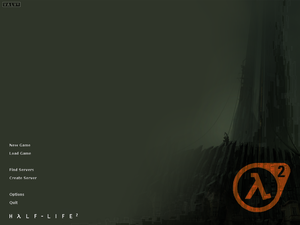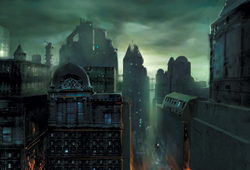Development of Half-Life 2
See our disclaimer about the leaked material. |
| The contents of this article have been cut. | ||
|---|---|---|
The subject matter of this article contains in-development information that was cut from the final version of an official and/or canonical source and appears in no other canonical source. It may also contain incomplete information since not all cut material is publicly known. |
| Warning! This article has yet to be cleaned up to a higher standard of quality, per our Cleanup Project. It may contain factual errors and nonsense, as well as spelling, grammar and structure issues, or simply structure problems. Reader's discretion is advised until fixing is done. | ||
|---|---|---|
You can help clean up this page by correcting spelling and grammar, removing factual errors and rewriting sections to ensure they are clear and concise, and moving some elements when appropriate. |
- "There is a lot of value in refinement. There's an aggressive statement of this principle, which isn't entirely true but it's still interesting: It doesn't matter what we cut, so long as we cut it and it gives us the time to focus on other things, because any of the options will be bad unless they're finished, and any of them will be good if they are finished."
- ― Gabe Newell[src]
The development of Half-Life 2 began almost immediately after the release of Half-Life, spanning from 1999 to the release of Half-Life 2 in 2004. During that elongated process, many things were outlined, created and cut before the game's final release.
Within the Half-Life community, this period is referred to under several names. They include:
- Development stage names, such as "Half-Life 2 Alpha", "Half-Life 2 Beta", or simply "Alpha" or "Beta". These terms, coined by the community and not Valve, are used incorrectly most of the time when referring to a particular subject of this period, as no development stages for any subject is known. Despite this, they are widely used across the community, as they are commonly used in the general gaming community to refer to any early stages of a video game. Therefore they should be taken as placeholder names referring to large periods of a game's development, "Alpha" being used for the early stages, "Beta" for the last stages that precede the retail release.
- The "Half-Life 2 leak" (or simply "the leak"), when referring to the material stolen (or "leaked") from Valve in 2003 by German hacker Axel Gembe, including source code, about 1300 maps, and a playable game (referred to by Gembe as "Chosen 9"). These files of course include anything referred to by the community as "Alpha" or "Beta". Valve does not refer to it as a leak but as a theft.[1]
- All in all the correct terms are "Half-Life 2 leak" or the "playable Half-Life 2 leak" for the stolen content. When referring to early elements of Half-Life 2, the terms "early Half-Life 2 build" or "early version of Half-Life 2" would be more appropriate, as well as, for instance, "the early City 17" or "the early Breencast". "Alpha" and "Beta" should never be used unless specifically stated. This also applies to any other development period of any other Valve game.
Contents
Early plotlines[edit]
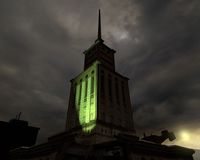
The book Half-Life 2: Raising the Bar and the numerous leaked files revealed many of the game's original settings and action that were either cut down or removed entirely from the final game. Half-Life 2 was originally intended to be a far darker game based on far grittier artwork where the Combine were more obviously draining the oceans for minerals and replacing the atmosphere with noxious, murky gases.
Half-Life 2 was also originally intended to be much more diverse in settings, and the original journey was extremely long (to the extent that the game felt almost overblown, with little time being spent on developing existing characters; one of the key reasons for it being cut). Several City 17 levels at the start of the game and complete chapters from the second half of the game were completely removed and sometimes re-introduced in the subsequent Half-Life 2 episodes.
Parts of the book Half-Life 2: Raising the Bar and the leaked files detail how Gordon would fight alongside characters such as Odell in the Borealis, as well as fighting together with Captain Vance and Vance's forces, the Conscripts, in the Air Exchange, the Weather Control and the rooftops of City 17. Originally, Eli and Alyx Vance had no relation, and Eli's lab was located in a cave in a scrapyard and was much rougher than the better equipped laboratory within a hydroelectric power station in the retail version (the scrapyard area where the Gravity Gun tutorial takes place, being an auxiliary area as opposed to the bulk of the lab, is reminiscent of the original concept). The Citadel also looked very different, it was more round than the bulky Citadel from the final version.
Early styles[edit]
While the playable game leaked in 2003 is quite similar to the retail product and already heavily trimmed, this earlier period of development of the game shows a quite different style. At this point, City 17 was a menacing metropolis with many huge skyscrapers, resembling American cities, and had a very basic, blocky FPS design.[2] It was more faithful to the concept art seen in Raising the Bar: darker, gothic, sinister, rainy, foggy, gritty, with a lot of brick, metal and glass, getting along well with the cut concept of the Combine replacing the air with poisonous gas and draining the oceans. It was therefore a much more dystopian, Orwellian universe (even though the final product is still quite Orwellian) even with touches of cyberpunk/steampunk style, in the vein of the book/film 1984 or other films such as Dark City, City of Lost Children, Avalon or Blade Runner. It was also more faithful to Viktor Antonov's early concept art and work on the game.
The Combine was rather using and recycling the existent human materials and buildings, instead of adding their own technology to them. This is why, for instance, the early Citadel had its walls covered with tiles.
During the time span leading to the 2003 leak, the team added more periods, such as the 30's, the 40's and the 70's, to finally get to a more Eastern post-Communist style we see in the retail version of the game, with older and smaller buildings, and a bright universe instead of a dark one, which is more in the vein of the original Half-Life. The Ravenholm levels are a reminiscence to the original style, even though the American East Coast-style skyscrapers were all removed.
Note that not all the concepts were not present in the development process at the same time, since the game had still a very rough, work-in-progress state.
Half-Life 2 leak[edit]
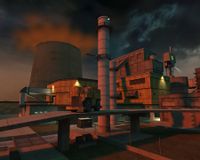
An unfinished version of Half-Life 2 was leaked on the internet on October 7, 2003.[3][4]
Other files consisted in a group of several zip files nicknamed "WC map pack" (WC stands for Worldcraft, the early name for Hammer, the level editor), containing around 1300 VMF maps (VMF stands for "Valve Map File") of the very early chapters already cut in the playable game mentioned above (most of them are repeated and almost identical), demo/prototype maps and the maps from the playable version, spread in around 60 folders named by the developers who worked on them, and making up around 3 gigabytes. These maps can be opened in Hammer and can be run in any Half-Life game after texture fixing (since several textures can be missing, especially the original Combine metal variations) and compiling into BSP maps (using the option "Create a Mod" in the SDK and putting the textures from the playable leak in its folder will do most of the preliminary work, as most of the textures will be missing if the compiled map is played on a released game). The maps still have the date they were last modified, which can give other clues about the game development. Most of the maps are very old and were last edited/created in 2001 or 2002.
The leaked files available on the Internet are obviously only parts of the original files used in the development of Half-Life 2, since many more maps, models, sounds, scripts, and textures were created, as well as more than 50,000 reference photos taken in USA and Europe used for design inspiration.[5][6] Despite the final game's release, these files are still illegal to redistribute.
Development timeline[edit]
1999[edit]
- June 1999: Development of Half-Life 2 begins.
- Early plot ideas are discussed and one of these ideas is this: Gordon Freeman is to travel to other planets and destroy the Xen forces on them.
- Viktor Antonov, Valve's art director, suggests that the game take place in an Eastern European city. The team likes this idea.
- Development of the Source engine begins. The main focuses are creating a physics system and a system capable of showing realistic facial expressions.
2000[edit]
- Plot begins to solidify. It takes place in a world dominated by an evil empire called the Combine. Many enemy and ally designs and a few WC map pack maps are made.
2001[edit]
- Sometime in 2001: Gabe Newell begins to focus on Steam and allows the Half-Life 2 team to design the game without his guidance.
- Before Summer 2001: Physics are integrated into the Source engine.
- Summer 2001: Advances in technology convince the developers to create a test map that features a battle between rioting Citizens and Metrocops.
- Summer 2001: Creation of the first test map, Get Your Free TVs!. While basic and extremely blocky, this gives the team a major morale boost and convinces them to start working on a trailer for E3 2002.
2002[edit]
- Sometime in Winter 2002, the trailer is finished. The team wishes to show it to Newell, who, as an outsider to what's been going on in the project, would give the team honest feedback.
- March 2002: Steam is announced at the 2002 Game Developers Conference.
- March 2002; After returning from the conference, the trailer is shown to Newell; he is unimpressed and believes that it needs more time to be developed. Morale takes a hit, but recovers.
- Summer 2002: The team begins to improve the trailer and sees that Newell was right.
- September 2002: Improved trailer is shown to Jay Stelly; he is unimpressed. As a result, the team works overnight to improve it. The next day, the new trailer is shown and impresses both Stelly and Newell.
- October 2002: Newell tells the team that they should get a new trailer ready for E3 2003 and expect the game to be shipped out by the end of 2003.
- October 2002: The first WC map pack maps for the retail storyline are made
Before December 2002[edit]
- The Wasteland and the Combine Factories section of City 17 are scrapped. Maps for their appearances at E3 2003 in the WC map pack indicate this.
2003[edit]
- February 2003: Newell announces that Half-Life 2 should be done by September 30, 2003. They still plan on making an E3 demonstration.
- May 2003: Half-Life 2 is shown at E3 to much acclaim. Some wonder why there was no playable demo at E3, but are ignored by both Valve and a majority of the fans.
- Soon after E3 2003: the team begins to see that Half-Life 2 will not be ready on September 30. Newell tries to stay optimistic, but even he begins to see that its impossible.
- July 29: Vivendi Interactive, Valve's publisher back then, announces that the game has been held back to "holidays 2003". Newell reaffirms the September 30th release date when asked about it, even though the team knows the date is impossible to reach.
- July 29 to September 23: Valve continues to reassert that the game will ship on September 30, even though everybody on the team knows that is impossible. Fans start to become skeptical the closer it gets to September 30.
- September 23: Newell announces that the game is being held back. Many fans, notably Fragmaster, head of Planet Half-Life, become enraged at Valve for lying to them about the release date. Some claim that they'll never buy anything from Valve again.
- October 4: The Source source code is leaked onto the Internet.
- October 7: The state of the game, as of October 4, 2003, is leaked onto the Internet. In addition, the WC map pack, a collection of every map made by Valve up to that point (in VMF format), a port of Half-Life to the Source engine, an extremely early version of Counter-Strike: Source, Counter Strike: Condition Zero, and two player models from Team Fortress 2 are leaked as well. Those that play it see that the game was nowhere near done and that quite a few E3 demos were scripted, when Newell himself said they weren't. Morale at Valve takes an extreme hit.
2004[edit]
- Early 2004: Morale begins to recover. Fans await the release of Half-Life 2, despite earlier outrage.
- Early March: The game can be played from start to finish. Play-testing begins.
- Late July: Game content is locked down. Testing is focused on fixing the physics system, getting rid of bugs and making levels more fun to play.
- October 13: The last release candidate is sent to Vivendi. Vivendi approves of it. Half-Life 2 can now be released.
- October 14: Newell destroys a Scanner-shaped piñata in celebration of the game being done.
- November 16: Half-Life 2 is released in retail and on Steam. Response is overwhelmingly positive.
Changes[edit]
Gameplay changes[edit]
Weapons[edit]
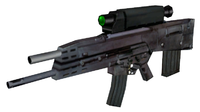
- Earlier versions of the game had a much larger and varied armory. See the weapons cut from Half-Life 2 for more details.
- Originally, the player could only hold a limited number of weapons. They could drop a weapon any time by taking the gun out, then hitting a key to drop it.[7] By the time the leak was made, the ability to drop weapons seems to have been removed, as the G key is bound to a function called "DropPrimary", but it does nothing.
- At one point, the player could fire their weapon while zoomed in. This was dropped for balance reasons (however, vehicle mounted weapons can be fired while zoomed in; in addition, the zoom can be used as a makeshift scope by holding down the fire button and zoom button, then releasing zoom).
- Some of the earliest weapons in the game were the AR1 and MP5K, both of which were dropped in the final version. Their early textures can be found in "materials\Models\Weapons\Obsolete" in the Beta. It has been suggested that the bulk of the weapons were cut due to the fact that they were too similar to one another, as the AR1 served a very similar role to the AR2, and the OICW the same to the SMG1.
- One of the earliest attempts at physics-enhanced gameplay was a weapon called the Brickbat. It would allow players to pick of objects from the ground and throw them at enemies. Due to how many view models they would have to model for it to feel natural, it was cut. The Gravity Gun performs the same function as Brickbat did, but in a much easier way (at least for the art team).
- Most, if not all of the cut weapons are usable in the playable leak and the mod Missing Information, although sometimes with some changes.
Mapping[edit]
- Early Half-Life 2 maps were built similarly to Half-Life maps; most of the objects in levels were made out of brushes.
- In some of the earliest maps, Half-Life entities, such as "monster_generic", are used to represent characters such as Barney and citizens.
- In later early maps the player would be able to place "prop_objects" in front of doors, barricading them so that enemy NPC would have to kick the door down in order to gain entry (shown in the early Ravenholm or
trap_townmaps).
Friendly fire[edit]
Half-Life 2 originally featured friendly fire, as with Half-Life. Valve found this to be annoying to playtesters, as they would often accidentally kill their teammates, so it was changed so the weapons do no damage to friendlies.
Characters[edit]
Combine[edit]
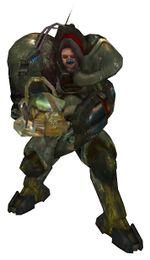
- Early drafts of the Combine soldiers were to make them look distinctively alien, but this was dropped when Valve wanted "a more transparent enemy".
- Originally, the Combine were to recycle human building materials for their own purposes. This resulted in somewhat odd designs, such as the Citadel's interior being made out of ceramic tiles.
- One of the sound files for two Metrocops walking through the Skyscraper (sound\vo\sky in the Beta) indicates that Combine-developed weaponry could only be used by those with "a messed up nervous system" and that non-standard issue weapons for Metrocops (such as Rocket Launchers) would be confiscated if not approved by Dr. Breen (at this point of development the Consul).
Monsters[edit]
- Tripod Hopper.
- The Particle Storm.
- The Combine Assassin.
- The Alien Assassin.
- The Bullsquid.
- The Houndeye.
- The Cremator.
- The Hydra.
- The Synth Combine Guard.
Citizens[edit]
- Originally, citizens were supposed to wear gas masks because of the Air Exchange making the air poisonous. This was dropped at the same time as the AirEx.
- There were to be child and adult workers at the factory section of City 17.
- During the Street War, there was to be a special type of Citizen that would give the player ammo. The only proof of his existence is a texture sheet in the 2003 leak.
Major Characters[edit]
- Alyx's father was originally a white man named Captain Vance. He was the head of security in the AirEx, and was to start the fighting that would ultimately destroy it.
- Eli used to have no relation with Alyx, though they were to be very close. Instead, he was an eccentric old man called living in a scrapyard, with the last name Maxwell instead of Vance.
- Older sound files indicate that in early story drafts, Eli lost his leg while trying to examine a Particle Storm.[8]
- Captain Vance and Maxwell were merged to create the Eli seen in the final version.
- Alyx originally wore a futuristic jumpsuit and a green jacket (more in line with other early 2000's sci-fi shooters), but this was scrapped a short time before the E3 demos were shown.
Locations[edit]
- City 17
- Wasteland
- Depot
- Air Exchange
- Borealis
- Kraken Base
- Weather Control
- Skyscraper
- Street Wars
- Citadel
Vehicles[edit]
- AirEx Truck (as a static prop)
- Digger
- Jet Ski
- Israeli Merkava (used by the conscripts)
- VAB APC (also used by the conscripts)
Fate of the cut material[edit]
Many of the cut concepts will never be reused. There are some exceptions, however, and some elements finally made their way into the released games.
Half-Life 2 (retail)[edit]
- The Combine Elite gathering all of the elite units concepts, notably the Combine Super Soldier and the Combine Assassin.
- The Alien Assassin was recycled into the Fast Zombie.
- Ravenholm being originally located at the end of the canals and before Eli's lab, it featured a lake at its foot, with at least one Ichthyosaur. This lake and the small docks were somehow kept for Black Mesa East when the chapter orders was reversed, and for the only Ichthyosaur appearance during the teleportation failure at the start of Half-Life 2.
- Odell's model was used and reworked for Odessa Cubbage.
- One of the Borealis' door props is used only as an entrance door for the Vortigaunt Camp.
- A similar scene with a small battle where Gordon has to fight a Combine helicopter (Ka-27 in the playable leak's final canal map, d1_canals_end) as the only final chapter's mini-boss. It was mostly reused and heavily improved upon, and in the final version in the finalized map, d1_canals_13, Gordon has to directly fight off a Hunter-Chopper.
Lost Coast[edit]
- Lost Coast itself was based on a chapter cut from Half-Life 2 and finally released as an HDR technology demo. However, none of its material is in the leaked files.
- The lines were originally written for Odell, was reused (though heavily rewritten) for the Fisherman.[9]
Half-Life 2: Episodes[edit]
- Originally the Classic Zombie, after be killed by the player at the Headcrab, exposed to having a half-skull, with only the jaw part intact. Was recycle for the Zombine.
- The Zombine itself was to originally appear in Half-Life 2, based off remaining text files in the playable leak.
Episode One[edit]

- The Air Exchange train wreck featured in the vignette Alyx[10] was reused at the start of the chapter Lowlife.
- The huge destroyed concrete level at the start of Vertigo seem to have been re-used in the City 17 Underground in the chapter Lowlife, where Gordon and Alyx are fighting Antlions and Gordon must find cars to block the Antlion holes.
- The Stalkers, originally to be fought in Half-Life 2, are at last directly confronted in Episode One.
- The Citadel Core was to appear in Half-Life 2, since a prototype map exists in the WC map pack.
- The Advisor room. The tube used by Advisor pods to leave exists in a very old WC map pack map.
- Judith Mossman and her predecessor, Elena's idea of wearing a Winter Coat as seen from the leak files, were been resurrected as seen from an encrypted video recording, but in a completely different design.
Episode Two[edit]
- The Air Exchange train wreck was reused at the very start of the game, while at some point wrecked train cars in a valley were to be seen at the end of the Canals before Ravenholm, somehow recycled for the start of Episode Two.[2]
- The Antlion caves.
- The Antlion Grubs, that were to be met in those caves.
- The Antlion King, that was also to be met in those caves, recycled into the Antlion Guardian.
- Some mining themes cut from Ravenholm, such as carts, were reused for the Victory Mine area.
- The Synth Combine Guard AI was recycled for the Hunter.
- The Hopwire Grenade's purpose and function are restored for the Magnusson Device.
Episode Three[edit]
- The Borealis will most likely be seen or visited, as the Aperture Science ship.
- Kraken Base, the Arctic base where Judith Mossman probably sent her message from, might also be visited, possibly under a different name. Elena Mossman was indeed stationed in Kraken Base in the early storyline.
Half-Life: Alyx[edit]
- The City 17 logo can be seen, such as in the TV broadcasts.
- Manhack's old mortar sounds heard in the Leak and E3 2003 trailers are reused during gameplay shootouts.
- The concept of the Combine Workers is reused, with the Hazmat Workers as a version of it. However, most of them are only encountered as corpses and in Zombified forms.
- The Vorti-Cell's concept and purpose got recycled through the Combine's use of modified Combine Cells to harvest energy from captive Vortigaunts.
- The concept of Alyx's Hideout is reminiscent of a "cache" place mentioned in her placeholder audio found in the Leak.
Mods[edit]
Since the release of the retail game in 2004, many attempts have been made to restore the original storyline by making mods based on the leaked files.[11] Some mods never went further than rough development stages and some fixes while some are still in development. Also, some players fixed several maps without including them in a full game. These can be found across the web.
One of the most famous mods based on the Beta is Missing Information. While originally considered "illegal content" by Valve, it has since been deemed legal as long as it is distributed for free as a mod and does not use the original source code. The mod's current version includes the E3 2003 presentation and an incomplete Borealis chapter.
Half-Life 2 demonstrations[edit]
Behind the scenes[edit]
There is a line[i] that can be found in the Half-Life 2 leak, which was to be said by a security guard in a port of the Hazard Course from the original game. The line is: "Sorry, sir. You know I can't let you through here without your good friend Superfly Johnson. Wa hah. Just kidding, Gordon. You go on through. Hah haha!". This is a reference to Superfly Johnson character from the video game Daikatana, best known for his poor pathfinding skills. He is an ally, and has to follow the player through some levels. If the player reaches a loading point and the character is not with the player, the player character will say: "I can't leave without my buddy, Superfly!". It also a reference to a line[i] said by the security guard when Gordon tries to go through a checkpoint without his suit on. The line is: "Sorry, Mr. Freeman, I got explicit orders not to let you through without your hazard suit on."
Menu gallery[edit]
Oldest known Half-Life 2 menu background. Based on a view from Central Park. The buildings are, left to right, The Pierre, The Sherry-Netherland, the General Motors Building, The Plaza and the Solow Building.[12]
More recent menu background, featuring Gordon Freeman (based on that image).
Other menu background, left out in the Dark Messiah of Might and Magic (a non-Valve game using the Source engine) texture files.
See also[edit]

See these related articles for more information on the early Half-Life 2:
References[edit]
- ↑ Marc Laidlaw Vault on the ValveTime Forums
- ↑ 2.0 2.1 WC map pack
- ↑ Playable version of Half-Life 2 stolen on CNN (October 7, 2003)
- ↑ I need the assistance of the community on ValveTime (October 2, 2003)
- ↑ Half-Life 2: Raising the Bar, page 238
- ↑ Half-Life 2: Raising the Bar
- ↑
 Half-Life 2 at E3 2003: Coastline on YouTube
Half-Life 2 at E3 2003: Coastline on YouTube
- ↑ Half-Life 2 leak
- ↑ Marc Laidlaw's Twitter. "It was a polished version of tests Wedge did for long winded NPCs to resume speech after they were interrupted. I did temp audio for him, originally all Borealis based, that got cannibalized and then done up nice for LC."
- ↑ Half-Life 2: Raising the Bar, page 150
- ↑ List of cut-content based mods on HL Project Beta
- ↑ View from the Wollman Rink, Central Park, Manhattan, New York City on Flickr
External links[edit]
Misc.[edit]
- "I need the assistance of the community" - the original thread created by Gabe Newell on the Halflife2.net forums on October 3, 2003
- The Boy Who Stole Half-Life 2 - article about Axel Gembe on Eurogamer
- The Truth Behind The Half-Life 2 Robbery on Rock, Paper, Shotgun
Beta footage[edit]
 Half-Life 2 E3 2002 Trailer on YouTube
Half-Life 2 E3 2002 Trailer on YouTube First sight of the Source engine at E3 2003, part 1 on YouTube
First sight of the Source engine at E3 2003, part 1 on YouTube First sight of the Source engine at E3 2003, part 2 on YouTube
First sight of the Source engine at E3 2003, part 2 on YouTube Gameplay in various maps on YouTube
Gameplay in various maps on YouTube- Video of the original Kleiner's Lab sequence (test) for the Beta-based mod Dark Atmosphere on RuTube
Mods based on the development of Half-Life 2[edit]
- Team GabeN (part of Gabe's Love Tub, released but some works in progress left)
- The Axel Project (a rebuild of the Source Engine leaked in 2003, archived)
- Missing Information (released)
